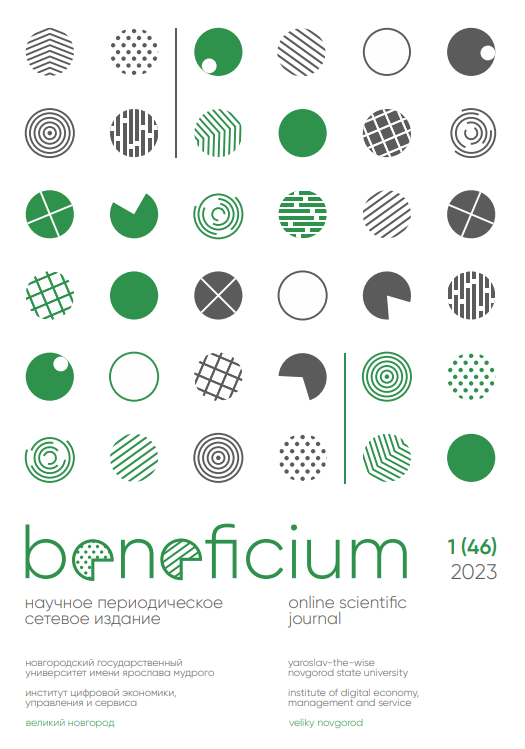DESIGNING THE STRUCTURE OF THE DATABASE CHARACTERIZING THE STANDART OF LIVING OF THE POPULATION OF RUSSIAN REGIONS AND THE SOCIO-ECONOMIC FACTORS THAT DETERMINE IT
Abstract
To be able to analyze, assess and forecast socio-economic development of territories, it is necessary to have complete and objective information, the basis of which should be a generalized base of scientifically valid indicators, characterizing, on the one hand, the standard of living in the regions and the country as a whole, and on the other hand, the main social and economic factors that have a significant impact on it. Accordingly, the purpose of this article was to develop a structure of an open data base, characterizing the processes of convergence and divergence of income and expenditures of the population in the regions of Russia, which occur under the influence of various social and economic factors. Design of the database was based on the application of methods of formalization, algorithmization, structurization and grouping. As a result, the structure of the database was developed, it links data characterizing incomes and expenditures of the population, on the one hand, and the dynamics of socio-economic development of the subjects of the Russian Federation, on the other hand. It has enabled us, firstly, to form and systematize an optimum set of indicators covering all essential aspects of the phenomenon under study by integrating statistical information from different information systems and, secondly, to solve the problem of establishing relationships between parameters characterizing complex processes of formation and differentiation of incomes and expenditures of the population as well as the influence of social and economic factors on these processes. Scientific significance of the results of the research consists in the fact that the formed data base through its target purpose, as well as greater specification of the subject (which determines the set of analyzed attributes – indicators) and specification of the research object allows using methods of mathematical statistics, system dynamic modeling, etc. to identify trends and determinants of differentiation of living standards of the country. The practical significance of the research consists in optimizing the research process of finding reliable and representative data for the regions of Russia and the analyzed problem. In addition, the results of processing the data stored in the database will also allow us to determine the tools for improving the state policy of regional development of the Russian Federation in the context under consideration.
Keywords: income and expenditures of the population, database design, spatial differentiation, regional development, socio-economic development, standard of living
References
Wallace M., Hyde A., Vachon T. States of inequality: Politics, labor, and rising income inequality in the U.S. States since 1950 // Research in Social Stratification and Mobility. 2022. Vol. 78. P. 100677. DOI: 10.1016/j.rssm.2022.100677
Hu Zh. The effect of income inequality on human capital inequality: Evidence from China // Structural Change and Economic Dynamics. 2021. Vol. 58(4). Pp. 471-489. DOI: 10.1016/j.strueco.2021.06.015
Du M., He L., Zhao M. [et al.]. Examining the relations of income inequality and carbon productivity: A panel data analysis // Sustainable Production and Consumption. 2022. Vol. 31(14). Pp. 249-262. DOI: 10.1016/j.spc.2022.01.027
Aaberge R., Atkinson A.B., Modalsli J. Estimating long-run income inequality from mixed tabular data: Empirical evidence from Norway, 1875-2017 // Journal of Public Economics. 2020. Vol. 187(4). P. 10496. DOI: 10.1016/j.jpubeco.2020.104196
Brzezinski M., Myck M., Najsztub M. Sharing the gains of transition: Evaluating changes in income inequality and redistribution in Poland using combined survey and tax return data // European Journal of Political Economy. 2022. Vol. 73(3). P. 102121. DOI: 10.1016/j.ejpoleco.2021.102121
Feld L.P., Frey C., Schaltegger C.A., Schmid L.A. Fiscal federalism and income inequality: An empirical analysis for Switzerland // Journal of Economic Behavior and Organization. 2021. Vol. 185. Pp. 463-494. DOI: 10.1016/j.jebo.2021.02.028
Gorshkov A.A. «Great discrepancy»: the growth of inequality in household income distribution and redistribution in the countries of the Organization for Economic Co-Operation and Development (OECD) (Russia, Moscow) // Problems of Modern Economics. 2016. Vol. 1(57). Pp. 47-52. (In Russ.).
Wang Q., Yang T., Li R. Does income inequality reshape the environ-mental Kuznets curve (EKC) hypothesis? A nonlinear panel data analysis // Environmental Re-search. 2023. Vol. 216. P. 114575. DOI: 10.1016/j.envres.2022.114575
Su D., Alshehri K., Pagán J. Income inequality and the disease burden of COVID-19: Survival analysis of data from 74 countries // Preventive Medicine Reports. 2022. Vol. 27. P. 101828. DOI: 10.1016/j.pmedr.2022.101828
Anindya K., Marthias T., Vellakkal S. [et al.]. Socioeconomic inequalities in effective service coverage for reproductive, maternal, newborn, and child health: a comparative analysis of 39 low-income and middle-income countries // EClinicalMedicine. 2021. Vol. 40. P. 101103. DOI: 10.1016/j.eclinm.2021.101103
Elgar F.J., Stefaniak A., Wohl M.J.A. The trouble with trust: Time-series analysis of social capital, income inequality, and COVID-19 deaths in 84 countries // Social Science and Medicine. 2020. P. 113365. DOI: 10.1016/j.socscimed.2020.113365
Bogomolov E.V. Russian household financial behavior characteristics // Ekonomika. Nalogi. Pravo [Economics, Taxes & Law]. 2020. Vol. 13(1). Pp. 49-59. (In Russ.). DOI: 10.26794/1999-849X-2020-13-1-49-59
Bychkova S.G. Statistical analysis of income differentiation: international and regional comparisons // Vestnik Universiteta. 2015. Vol. 5. Pp. 131-139. (In Russ.).
Sepulveda E.R., Brooker A.S. Income inequality and COVID-19 mortality: Age-stratified analysis of 22 OECD countries // SSM – Population Health. 2021. Vol. 16. Pp. 1-6. DOI: 10.1016/j.ssmph.2021.100904
Abila D.B., Wasukira S.B., Ainembabazi P. [et al.]. Socioeconomic inequalities in prostate cancer screening in low- and middle-income countries: an analysis of the demographic and health surveys between 2010 and 2019 // Journal of Cancer Policy. 2022. Vol. 34. DOI: 10.1016/j.jcpo.2022.100360
Popov A.V. Use of information and analytical system of monitoring labor potential of territories for regulating labor behavior of population // Vestnik NSUEM. 2016. Vol. 1. Pp. 189-199. (In Russ.).
Strekalova N.V. Databases on the problems of studying social stratification and mobility of urban elites and the middle strata of Tambov in the late 19th – early 20th centuries: sources, structure, technology of complex analysis // Istoricheskaya Informatika [Historical Informatics]. 2021. Vol. 4(38). Pp. 50-66. (In Russ.). DOI: 10.7256/2585-7797.2021.4.36987
Bryukhanova E.A., Nezhentseva N.V., Chekryzhova O.I., Ivanov D.N. A database built on the first 1897 Russian Empire population census data: structure and analysis // Istoricheskaya Informatika [Historical Informatics]. 2020. Vol. 1(31). Pp. 20-33. (In Russ.). DOI: 10.7256/2585-7797.2020.1.32387
Seifert J.W. Data mining and the search for security: Challenges for connecting the dots and databases// Government Information Quarterly. 2004. Vol. 21(4). Pp. 461-480. DOI: 10.1016/j.giq.2004.08.006
Qiao K., Dowell G. Environmental concerns, income inequality, and purchase of environmentally-friendly products: A longitudinal study of U.S. counties (2010-2017) // Research Policy. 2022. Vol. 51(4). P. 104443. DOI: 10.1016/j.respol.2021.104443
Bogomolova T.Yu., Tapilina V.S. Financial behavior of household in Russia in the mid-90s // Economics of Contemporary Russia. 1998. Vol. 4. Pp. 58-69. (In Russ.).
Igawa M., Managi S. Energy poverty and income inequality: An economic analysis of 37 countries // Applied Energy. 2022. Vol. 306(B). P. 118076. DOI: 10.1016/j.apenergy.2021.118076
Sebri M., Dachraoui H. Natural resources and income inequality: A meta-analytic review // Resources Policy. 2021. Vol. 74. P. 102315. DOI: 10.1016/j.resourpol.2021.102315
Mohtadi S., Castells-Quintana D. The distributional dimension of the resource curse: Commodity price shocks and income inequality // Structural Change and Economic Dynamics. 2021. Vol. 59(1). Pp. 63-78. DOI: 10.1016/j.strueco.2021.08.002
Lee J.S., Jun S.P. Privacy-preserving data mining for open government data from heterogeneous sources // Government Information Quarterly. 2021. Vol. 38(1). P. 101544. DOI: 10.1016/j.giq.2020.101544
Litvinova V.V., Nagernyak M.A., Kirillova M.N. The Atlas of social protection indicators of resilience and equity: opportunities for interregional comparisons // Financial Journal. 2017. Vol. 5(39). Pp. 33-46. (In Russ.).
Dyshlyuk S.S., Utrobina E.S. Creating and loading data base for statistical accounting of regional economic characteristics in the reference-analytical GIS tool // Interexpo Geo-Siberia. 2012. Vol. 1(1-2). Pp. 111-116. (In Russ).
Sample Survey of Household Income and Expenditures (2021). ROSSTAT. (In Russ.). URL: https://obdx.gks.ru/ (accessed on 22.12.2022)
About the Authors
Anatoliy A. Durkin – Graduate Student, Pitirim Sorokin Syktyvkar State University, Syktyvkar, Russia. E-mail: anatoliy.durkin@mail.ru
Andrei G. Shelomentsev – Dr. Sci. (Economics), Professor; Professor, Yugra State University, Khanty-Mansiysk, Russia. E-mail: a.shelom@gmail.ru. SPIN РИНЦ 9931-5778. ORCID 0000-0003-1904-9587. Scopus Author 56288580900. Researcher ID M-8644-2016
Ksenia S. Goncharova – Cand. Sci. (Economics); research associate, Institute of Economics of the Ural Branch of the Russian Academy of Sciences, Yekaterinburg, Russia. E-mail: kseniya.gon4arowa@gmail.com. SPIN РИНЦ 6154-9862. ORCID 0000-0003-2381-3322. Scopus Author 57219669945. Researcher ID K-4838-2018
For citation: Durkin A.A., Shelomentsev A.G., Goncharova K.S. Designing the Structure of the Database Characterizing the Standard of Living of the Population of Russian Regions and the Socio-Economic Factors That Determine It // BENEFICIUM. 2023. Vol. 1(46). Pp. 20-27. (In Russ.). DOI: 10.34680/BENEFICIUM.2023.1(46).20-27









